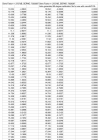- Thread Starter
- #41
I'd guess that is expected and makes some sense, because low frequencies are much less directional than high freqs.
So the lower the freq the less the direction of the mic should be relevant and the opposite for higher freqs.
So the lower the freq the less the direction of the mic should be relevant and the opposite for higher freqs.

